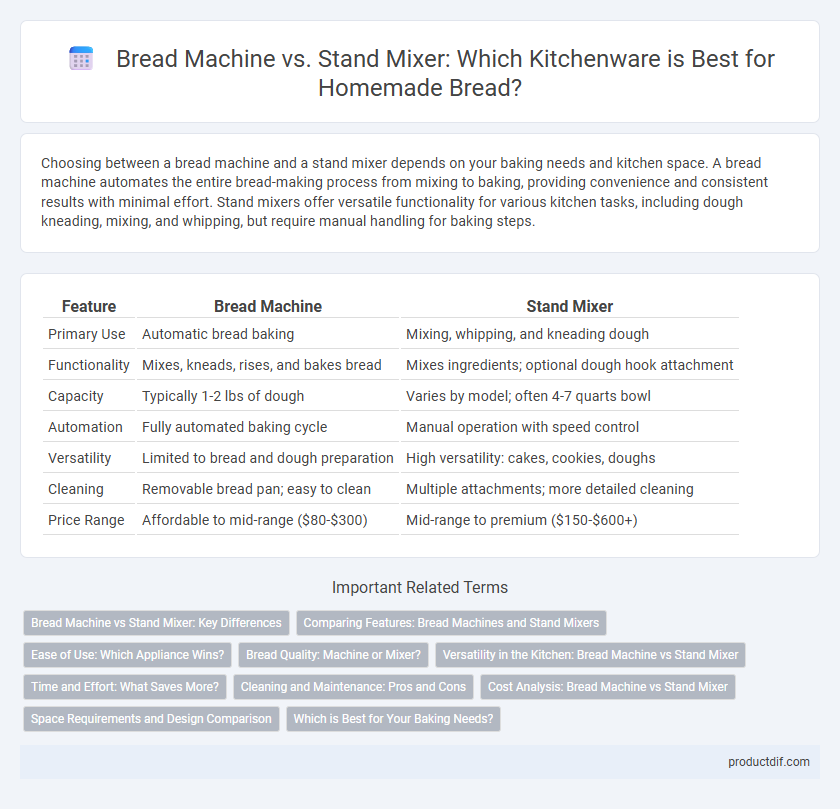Choosing between a bread machine and a stand mixer depends on your baking needs and kitchen space. A bread machine automates the entire bread-making process from mixing to baking, providing convenience and consistent results with minimal effort. Stand mixers offer versatile functionality for various kitchen tasks, including dough kneading, mixing, and whipping, but require manual handling for baking steps.
Table of Comparison
| Feature | Bread Machine | Stand Mixer |
|---|---|---|
| Primary Use | Automatic bread baking | Mixing, whipping, and kneading dough |
| Functionality | Mixes, kneads, rises, and bakes bread | Mixes ingredients; optional dough hook attachment |
| Capacity | Typically 1-2 lbs of dough | Varies by model; often 4-7 quarts bowl |
| Automation | Fully automated baking cycle | Manual operation with speed control |
| Versatility | Limited to bread and dough preparation | High versatility: cakes, cookies, doughs |
| Cleaning | Removable bread pan; easy to clean | Multiple attachments; more detailed cleaning |
| Price Range | Affordable to mid-range ($80-$300) | Mid-range to premium ($150-$600+) |
Bread Machine vs Stand Mixer: Key Differences
Bread machines automate the bread-making process with pre-programmed settings for kneading, rising, and baking, providing convenience and consistent results. Stand mixers offer versatile attachments for mixing dough, whipping, and other culinary tasks but require manual intervention for baking stages. Choosing between a bread machine and a stand mixer depends on whether you prioritize automated bread baking or multi-functional kitchen versatility.
Comparing Features: Bread Machines and Stand Mixers
Bread machines specialize in automated bread kneading, proofing, and baking with preset programs for various bread types, offering consistent results and convenience. Stand mixers feature powerful motors and multiple attachments enabling versatile mixing, kneading, whipping, and dough handling but require manual baking steps. Choosing between a bread machine and stand mixer depends on prioritizing automation and ease or multifunctional kitchen tasks and control.
Ease of Use: Which Appliance Wins?
Bread machines excel in ease of use with automated settings that require minimal input, making bread preparation straightforward and hands-free. Stand mixers offer versatility but often need manual monitoring and multiple attachments for bread dough, increasing the complexity for beginners. For consistent, hassle-free bread making, bread machines provide the most user-friendly experience.
Bread Quality: Machine or Mixer?
Bread machines consistently produce evenly baked loaves with a uniform crumb structure due to precise temperature control and automated kneading cycles. Stand mixers excel in dough development, allowing greater control over texture and hydration, but require manual baking to achieve optimal crust and crumb quality. For consistently high bread quality, bread machines offer convenience and reliable results, while stand mixers cater to bakers seeking customized dough handling and artisanal finishes.
Versatility in the Kitchen: Bread Machine vs Stand Mixer
A stand mixer offers greater versatility in the kitchen, capable of mixing dough, whipping cream, and preparing batters, whereas a bread machine is primarily designed for baking bread with automated kneading, proofing, and baking cycles. Stand mixers often come with multiple attachments such as pasta rollers, meat grinders, and spiralizers, expanding their functionality beyond dough preparation. Bread machines provide convenience for consistent loaf results but lack the multifunctional capabilities that make stand mixers a more adaptable tool for varied cooking tasks.
Time and Effort: What Saves More?
Bread machines save time and effort by automating the entire bread-making process, from mixing to kneading to baking, requiring minimal user intervention. Stand mixers provide versatile mixing capabilities but demand additional time and effort for manual kneading, shaping, and baking. For those prioritizing convenience and hands-off baking, bread machines offer a more efficient solution.
Cleaning and Maintenance: Pros and Cons
Bread machines typically require less frequent cleaning as most parts are non-detachable except for the baking pan and kneading blade, which are often dishwasher safe. Stand mixers involve more maintenance since attachments such as dough hooks and beaters must be cleaned after each use, and the mixer body needs regular wiping to prevent buildup. While bread machines offer convenience in cleaning, stand mixers provide versatility at the cost of more detailed upkeep.
Cost Analysis: Bread Machine vs Stand Mixer
Bread machines typically range from $80 to $300, offering an all-in-one solution for bread preparation, which can reduce the need for additional appliances and save money over time. Stand mixers generally cost between $200 and $600, with premium models exceeding $700, and while they offer greater versatility for mixing, kneading, and baking, the initial investment is higher compared to bread machines. Considering long-term usage, bread machines provide cost-effective convenience for frequent bread makers, whereas stand mixers justify their price through multifunctionality and durability.
Space Requirements and Design Comparison
Bread machines typically have a compact, boxy design focused on automating the bread-making process and require a dedicated counter space of about 12 to 14 inches in width and depth. Stand mixers feature a larger, more versatile build with attachments for multiple kitchen tasks, usually demanding 14 to 18 inches of countertop space and additional room for bowl clearance and accessory storage. The upright design of stand mixers contrasts with the low-profile footprint of bread machines, influencing kitchen layout and storage decisions.
Which is Best for Your Baking Needs?
A bread machine excels at automating dough preparation and baking processes, delivering consistent, hands-free bread with customizable settings for various recipes. Stand mixers offer versatile mixing capabilities suitable for a wide range of baking tasks including whipping, kneading, and mixing, making them ideal for bakers who require multifunctional tools. Choosing between a bread machine and a stand mixer depends on whether you prioritize convenience in bread-making or versatile baking performance for diverse recipes.
Bread machine vs Stand mixer Infographic

 productdif.com
productdif.com